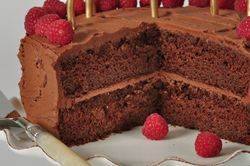|
 What
is the proper name for that sweet sugary mixture used to fill and cover
cakes, pastries and other confections? The answer may depend on
where you live. Americans tend to use the word 'frosting'.
Other countries tend to use the word 'icing'. The name 'icing'
probably has something to do with the fact that 'confectioners' or
'powdered' sugar is also known as 'icing' sugar. Hence, combining
icing sugar with other ingredients makes an 'icing'. The fact is
that 'frosting' and 'icing' are the same thing and food writers used
them interchangeably. What
is the proper name for that sweet sugary mixture used to fill and cover
cakes, pastries and other confections? The answer may depend on
where you live. Americans tend to use the word 'frosting'.
Other countries tend to use the word 'icing'. The name 'icing'
probably has something to do with the fact that 'confectioners' or
'powdered' sugar is also known as 'icing' sugar. Hence, combining
icing sugar with other ingredients makes an 'icing'. The fact is
that 'frosting' and 'icing' are the same thing and food writers used
them interchangeably.
There are
numerous types of frostings (icings), both thick and thin, cooked and
uncooked, starting with a simple mixture of powdered sugar and water, to
beating hot sugar syrup into stiffly beaten egg whites, cooling and then
beating in softened butter to make what is called an Italian
Buttercream. What is important in deciding what type of
frosting to use is to match the icing to the baked good.
That is, the icing should complement the flavors and texture of the
dessert being frosted. For example, a cinnamon bun (roll) is
wonderful drizzled with a simple icing of powdered sugar and milk but
this would not be suitable for frosting a chocolate butter cake. A
rich buttercream will perfectly complement a butter cake, but might
overpower a delicate sponge. Also, the frosting used to fill the cake
can be different from what it used to cover the top and sides of the
cake. A white butter
cake is lovely when filled with lemon curd and raspberry pur? and then
encased in white buttercream or confectioners frosting.
It is very
important that the frosting be the proper consistency so it spreads
easily over the baked good, yet at the same time adheres to the surface.
Never frost a cake or any other pastry that is still warm as the
frosting will melt into the baked good or become too thin and run.
Also be sure to brush all loose crumbs from the baked good before
frosting to ensure a smooth finish, as you do not want your finished
product to be laced with crumbs.
Some soft cakes benefit from first covering the cake with a very thin
layer of icing (called a crumb coat), letting it dry, and then frosting.
Oftentimes those soft and delicate cakes, besides being crumb coated, need
to be frozen first before frosting so they won't fall apart. Just
make sure you defrost the frosted cake before serving.
Types of
frostings (icings) and their uses:
Buttercream
is a name that encompasses a broad range of icings that can differ by
person, city, region, or country. They can be quick or complicated
to make depending on whether they are cooked or uncooked.
Buttercreams may contain powdered sugar, white granulated sugar, whole
eggs, egg whites, egg yolks, unsalted butter, shortening, milk or cream,
pastry cream, fondant, and various flavorings (extract, pur?,
chocolate, liqueur). Generally, buttercream is a light and creamy
smooth icing used to fill, frost and decorate (flowers, leaves, etc.)
all kinds of cakes and pastries. Some cooked Buttercreams are meringue-based where unsalted butter is beaten into
firmly beaten egg whites that have had hot sugar syrup added to them.
This produces a rich, yet light buttercream. French Buttercream
contains both whole eggs and egg yolks that have been beaten, to which a
sugar syrup is added and then unsalted butter.
Confectioners' Frosting is an uncooked
buttercream icing that contains powdered (icing) sugar, unsalted butter,
milk and flavoring.
Ganache is
both a frosting and a glaze and is widely used
in the pastry kitchen. When barely warm and liquid ganache is poured over a cake
or torte for a smooth shiny glaze. If cooled to room temperature it becomes a
spreadable filling and frosting. Refrigerated ganache can be
whipped for
fillings and frostings or formed into truffles. Ganache that is
whipped with
soft butter is called ganache beurre, which is like a buttercream, and is used
for fillings and frostings for cakes.
Royal Icing
was traditionally used to ice
Wedding and Christmas cakes and consists of
powdered (icing) sugar, egg whites or meringue powder and water. (If
you are worried about salmonella use the royal icing recipe that contains
meringue powder, not raw egg whites.) This pure white icing when dry
produces a perfectly flat, smooth and glossy hard surface which makes it ideal
not only for frosting cakes and cookies, but also for intricate
piping of
decorations (flowers, borders, lettering, etc.) You may have to
adjust the water and sugar used depending on whether you are using the icing for
decorations (fine lines, outlines, etc. needs a thinner icing) or to coat cakes
or cookies (thicker icing). In my opinion this is not the greatest tasting
icing and is best used only when you need that smooth and glossy hard surface.
Whipped Cream Frosting
is a great recipe that can be used to fill and frost any type of butter
or foam cake. Cocoa powder can be added to make chocolate whipped
cream or raspberry pur?/font>e
can be added for a wonderful fruit flavored whipped cream.
|